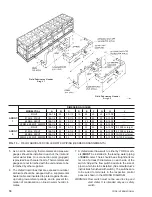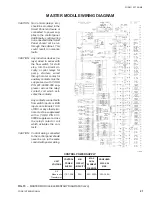
YORK INTERNATIONAL
32
UNIT CONTROLS AND OPERATION
YORK MICROCOMPUTER CONTROL CENTER
26572A
FIG. 21
MICROCOMPUTER CONTROL CENTER
INTRODUCTION
The YORK MicroComputer Control Center is a micro-
processor based control system capable of multi-cir-
cuit control to maintain chilled liquid temperature. The
chiller system is controlled by two control / power pan-
els in a Master / Slave configuration. The Master is rec-
ognized by the attached operator display and keypad
which provides control from a single operator location.
A 40 character display (2 lines of 20 characters) allows
the operator to display system operating parameters
as well as access programmed information already in
memory. On the Master Control Panel, a keypad for
programming and accessing setpoints, pressures, tem-
peratures, motor current, cut-outs, daily schedule, op-
tions, and fault information is provided. No Control Panel
is present on the Slave Panel.
A master ON / OFF switch is available to activate or
de-activate the chiller system. Separate system (SYS)
switches for each refrigerant system (up to 4) are pro-
vided on each Microprocessor Board.
Remote cycling, unloading, and chilled water tempera-
ture reset can be accomplished by used supplied dry
contacts.
Compressor starting / stopping and loading / unloading
decisions are performed by the Microprocessor to main-
tain leaving water temperature. These decisions are a
function of temperature deviation from setpoint and rate
of change of temperature.
MICROPROCESSOR BOARD
The Microprocessor Boards are the controller and de-
cision makers in the control panels. System inputs from
pressure transducers, temperature sensors, and C.T.s
are connected directly to the Microprocessor Board. The
Microprocessor Board circuitry multiplexes these ana-
log inputs, digitizes them, and constantly scans them to
keep a constant watch on the chiller operating condi-
tions. From this information, the Microprocessor then
issues commands to the Relay Output Board to control
contactors, solenoids, etc. for water temperature con-
trol and to react to safety conditions.
Two Microprocessor Boards, one acting as a master
and one as a slave controller are present in the chiller.
Control and programming for the entire chiller is pro-
vided by the Master Microprocessor Board. The mas-
ter also has direct control of compressor 1 and 2. The
Slave Microprocessor Board is responsible for direct
control of compressor 3 and 4 as dictated by the
Masters requirements. Communications and informa-
tion transmission between the two micros is accom-
plished by a 2 wire RS-485 communications link.
Keypad commands are acted upon by the micro to
change setpoints, cut-outs, scheduling, operating re-
quirements, and to provide displays.
















































